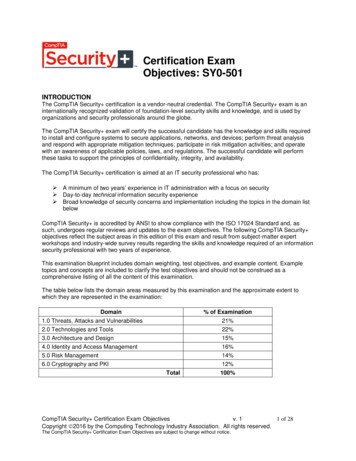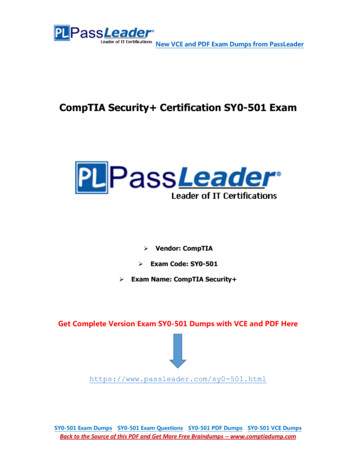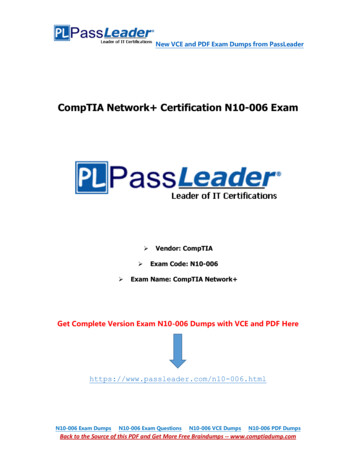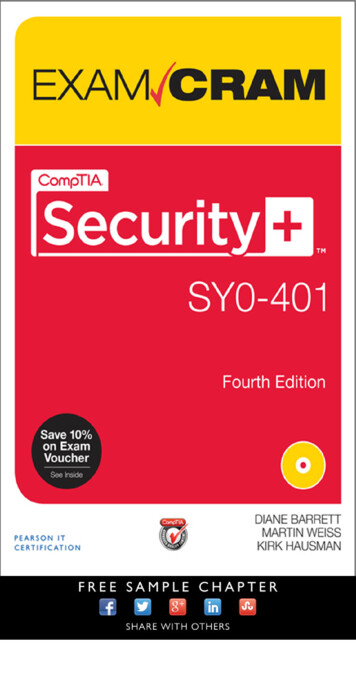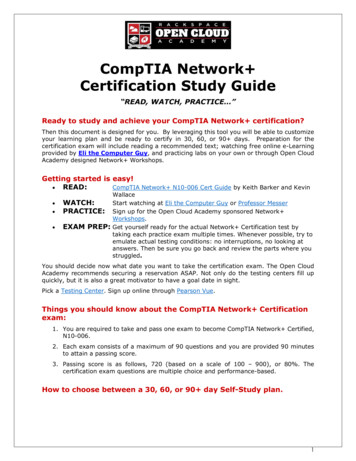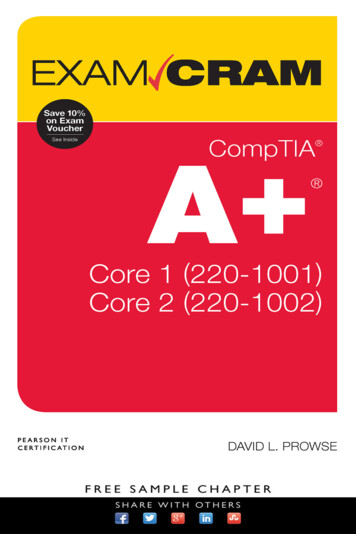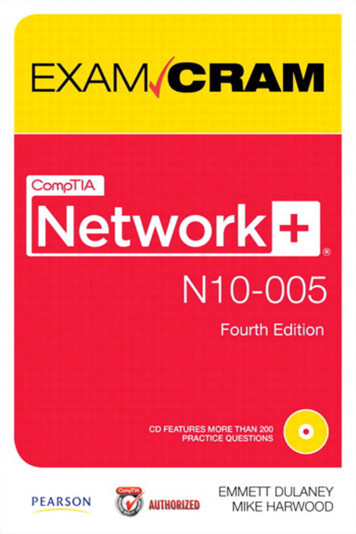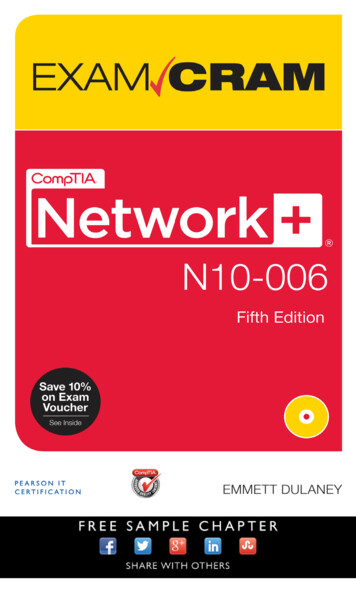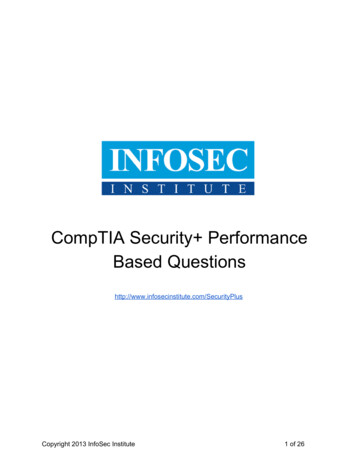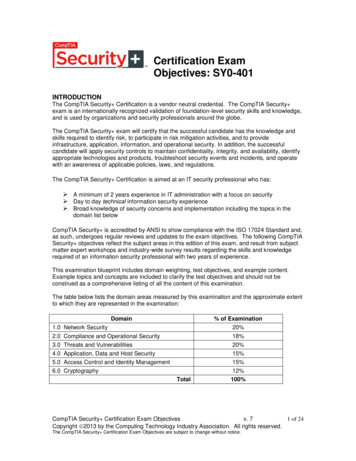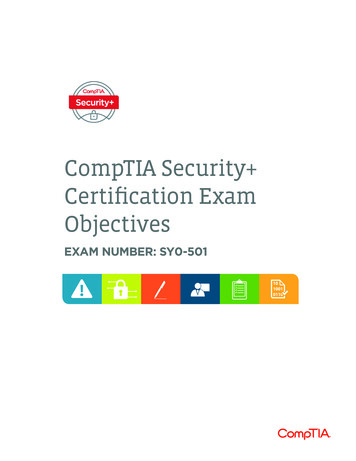
Transcription
CompTIA Security Certification ExamObjectivesEXAM NUMBER: SY0-501
About the ExamThe CompTIA Security certification is a vendor-neutral credential. The CompTIA Security exam is an internationally recognized validation of foundation-level security skills andknowledge, and is used by organizations and security professionals around the globe.The CompTIA Security exam will certify the successful candidate has the knowledge and skills requiredto install and configure systems to secure applications, networks, and devices; perform threat analysisand respond with appropriate mitigation techniques; participate in risk mitigation activities; andoperate with an awareness of applicable policies, laws, and regulations. The successful candidatewill perform these tasks to support the principles of confidentiality, integrity, and availability.The CompTIA Security certification is aimed at an IT security professional who has: A minimum of two years’ experience in IT administration with a focus on security Day-to-day technical information security experience Broad knowledge of security concerns and implementation, including the topics in the domain listThese content examples are meant to clarify the test objectives and should not beconstrued as a comprehensive listing of all content in this examination.EXAM ACCREDITATIONCompTIA Security is accredited by ANSI to show compliance with the ISO 17024 Standardand, as such, the exam objectives undergo regular reviews and updates.EXAM DEVELOPMENTCompTIA exams result from subject matter expert workshops and industry-wide surveyresults regarding the skills and knowledge required of an IT professional.CompTIA AUTHORIZED MATERIALS USE POLICYCompTIA Certifications, LLC is not affiliated with and does not authorize, endorse or condone utilizing anycontent provided by unauthorized third-party training sites (aka “brain dumps”). Individuals who utilizesuch materials in preparation for any CompTIA examination will have their certifications revoked and besuspended from future testing in accordance with the CompTIA Candidate Agreement. In an effort to moreclearly communicate CompTIA’s exam policies on use of unauthorized study materials, CompTIA directsall certification candidates to the CompTIA Certification Exam Policies. Please review all CompTIA policiesbefore beginning the study process for any CompTIA exam. Candidates will be required to abide by theCompTIA Candidate Agreement. If a candidate has a question as to whether study materials are consideredunauthorized (aka “brain dumps”), he/she should contact CompTIA at examsecurity@comptia.org to confirm.PLEASE NOTEThe lists of examples provided in bulleted format are not exhaustive lists. Other examples oftechnologies, processes or tasks pertaining to each objective may also be included on the examalthough not listed or covered in this objectives document. CompTIA is constantly reviewing thecontent of our exams and updating test questions to be sure our exams are current and the securityof the questions is protected. When necessary, we will publish updated exams based on existingexam objectives. Please know that all related exam preparation materials will still be valid.CompTIA Security Certification Exam Objectives Version 2.0 (Exam Number: SY0-501)
TEST DETAILSRequired examCompTIA Security SY0-501Number of questionsMaximum of 90Types of questionsMultiple choice and performance-basedLength of test90 minutesRecommended experience At least two years of experiencein IT administration with a focus on securityPassing score750 (on a scale of 100–900)EXAM OBJECTIVES (DOMAINS)The table below lists the domains measured by this examinationand the extent to which they are represented:DOMAINPERCENTAGE OF EXAMINATION1.0 Threats, Attacks and Vulnerabilities2.0 Technologies and Tools3.0 Architecture and Design4.0 Identity and Access Management5.0 Risk Management6.0 Cryptography and PKITotal21%22%15%16%14%12%100%CompTIA Security Certification Exam Objectives Version 2.0 (Exam Number: SY0-501)
1.0 Threats, Attacks and Vulnerabilities1.1Given a scenario, analyze indicators of compromiseand determine the type of malware. Viruses Crypto-malware Ransomware Worm Trojan Rootkit Keylogger Adware Spyware1.2 Bots RAT Logic bomb BackdoorCompare and contrast types of attacks. Social engineering- Phishing- Spear phishing- Whaling- Vishing- Tailgating- Impersonation- Dumpster diving- Shoulder surfing- Hoax- Watering hole attack- Principles (reasons for effectiveness)- Authority- Intimidation- Consensus- Scarcity- Familiarity- Trust- Urgency Application/service attacks- DoS- DDoS- Man-in-the-middle- Buffer overflow- Injection- Cross-site scripting- Cross-site request forgery- Privilege escalation- ARP poisoning- Amplification- DNS poisoning- Domain hijacking- Man-in-the-browser- Zero day- Replay- Pass the hash- Hijacking and related attacks- Clickjacking- Session hijacking- URL hijacking- Typo squatting- Driver manipulation- Shimming- Refactoring- MAC spoofing- IP spoofing Wireless attacks- ReplayCompTIA Security Certification Exam Objectives Version 2.0 (Exam Number: SY0-501)- IV- Evil twin- Rogue AP- Jamming- WPS- Bluejacking- Bluesnarfing- RFID- NFC- Disassociation Cryptographic attacks- Birthday- Known plain text/cipher text- Rainbow tables- Dictionary- Brute force- Online vs. offline- Collision- Downgrade- Replay- Weak implementations
1.0 Threats, Attacks and Vulnerabilities1.3Explain threat actor types and attributes. Types of actors- Script kiddies- Hacktivist- Organized crime- Nation states/APT- Insiders- Competitors1.4Explain penetration testing concepts. Active reconnaissance Passive reconnaissance Pivot Initial exploitation Persistence Escalation of privilege1.5 Black box White box Gray box Penetration testing vs.vulnerability scanningExplain vulnerability scanning concepts. Passively test security controls Identify vulnerability Identify lack of security controls Identify common misconfigurations1.6 Attributes of actors- Internal/external- Level of sophistication- Resources/funding- Intent/motivation Use of open-source intelligence Intrusive vs. non-intrusive Credentialed vs. non-credentialed False positiveExplain the impact associated with types of vulnerabilities. Race conditions Vulnerabilities due to:- End-of-life systems- Embedded systems- Lack of vendor support Improper input handling Improper error handling Misconfiguration/weak configuration Default configuration Resource exhaustion Untrained users Improperly configured accounts Vulnerable business processes Weak cipher suites and implementations Memory/buffer vulnerability- Memory leak- Integer overflow- Buffer overflow- Pointer dereference- DLL injection System sprawl/undocumented assets Architecture/design weaknesses New threats/zero day Improper certificate andkey managementCompTIA Security Certification Exam Objectives Version 2.0 (Exam Number: SY0-501)
2.0 Technologies and Tools2.1Install and configure network components, both hardwareand software-based, to support organizational security. Firewall- ACL- Application-based vs. network-based- Stateful vs. stateless- Implicit deny VPN concentrator- Remote access vs. site-to-site- IPSec- Tunnel mode- Transport mode- AH- ESP- Split tunnel vs. full tunnel- TLS- Always-on VPN NIPS/NIDS- Signature-based- Heuristic/behavioral- Anomaly- Inline vs. passive- In-band vs. out-of-band- Rules- Analytics- False positive- False negative2.2 Router- ACLs- Antispoofing Switch- Port security- Layer 2 vs. Layer 3- Loop prevention- Flood guard Proxy- Forward and reverse proxy- Transparent- Application/multipurpose Load balancer- Scheduling- Affinity- Round-robin- Active-passive- Active-active- Virtual IPs Access point- SSID- MAC filtering- Signal strength- Band selection/width- Antenna types and placement- Fat vs. thin- Controller-based vs. standalone SIEM- Aggregation- Correlation- Automated alerting and triggers- Time synchronization- Event deduplication- Logs/WORM DLP- USB blocking- Cloud-based- Email NAC- Dissolvable vs. permanent- Host health checks- Agent vs. agentless Mail gateway- Spam filter- DLP- Encryption Bridge SSL/TLS accelerators SSL decryptors Media gateway Hardware security moduleGiven a scenario, use appropriate software toolsto assess the security posture of an organization. Protocol analyzer Network scanners- Rogue system detection- Network mapping Wireless scanners/cracker Password cracker Vulnerability scanner Configuration compliance scanner Exploitation frameworks Data sanitization tools Steganography tools Honeypot Backup utilities Banner grabbing Passive vs. active Command line tools- ping- netstatCompTIA Security Certification Exam Objectives Version 2.0 (Exam Number: SY0-501)- tracert- nslookup/dig- arp- ipconfig/ip/ifconfig- tcpdump- nmap- netcat
2.0 Technologies and Tools2.3Given a scenario, troubleshoot common security issues. Unencrypted credentials/clear text Logs and events anomalies Permission issues Access violations Certificate issues Data exfiltration Misconfigured devices- Firewall2.4 Application whitelisting Removable media control Advanced malware tools Patch management tools UTM DLP Data execution prevention Web application firewallGiven a scenario, deploy mobile devices securely. Connection methods- Cellular- WiFi- SATCOM- Bluetooth- NFC- ANT- Infrared- USB Mobile device management concepts- Application management- Content management- Remote wipe- Geofencing- Geolocation2.6- Personal email Unauthorized software Baseline deviation License compliance violation(availability/integrity) Asset management Authentication issuesGiven a scenario, analyze and interpret output from security technologies. HIDS/HIPS Antivirus File integrity check Host-based firewall2.5- Content filter- Access points Weak security configurations Personnel issues- Policy violation- Insider threat- Social engineering- Social media- Screen locks- Push notification services- Passwords and pins- Biometrics- Context-aware authentication- Containerization- Storage segmentation- Full device encryption Enforcement and monitoring for:- Third-party app stores- Rooting/jailbreaking- Sideloading- Custom firmware- Carrier unlocking- Firmware OTA updates- Camera use- SMS/MMS- External media- USB OTG- Recording microphone- GPS tagging- WiFi direct/ad hoc- Tethering- Payment methods Deployment models- BYOD- COPE- CYOD- Corporate-owned- VDIGiven a scenario, implement secure protocols. Protocols- DNSSEC- SSH- S/MIME- SRTP- LDAPS- FTPS- SFTP- SNMPv3- SSL/TLS- HTTPS- Secure POP/IMAP Use cases- Voice and video- Time synchronization- Email and webCompTIA Security Certification Exam Objectives Version 2.0 (Exam Number: SY0-501)- File transfer- Directory services- Remote access- Domain name resolution- Routing and switching- Network address allocation- Subscription services
3.0 Architecture and Design3.1Explain use cases and purpose for frameworks, bestpractices and secure configuration guides. Industry-standard frameworksand reference architectures- Regulatory- Non-regulatory- National vs. international- Industry-specific frameworks3.2 Defense-in-depth/layered security- Vendor diversity- Control diversity- Administrative- Technical- User trainingGiven a scenario, implement secure network architecture concepts. Zones/topologies- DMZ- Extranet- Intranet- Wireless- Guest- Honeynets- NAT- Ad hoc Segregation/segmentation/isolation- Physical3.3 Benchmarks/secure configuration guides- Platform/vendor-specific guides- Web server- Operating system- Application server- Network infrastructure devices- General purpose guides- Logical (VLAN)- Virtualization- Air gaps Tunneling/VPN- Site-to-site- Remote access Security device/technology placement- Sensors- Collectors- Correlation engines- Filters- Proxies- Firewalls- VPN concentrators- SSL accelerators- Load balancers- DDoS mitigator- Aggregation switches- Taps and port mirror SDNGiven a scenario, implement secure systems design. Hardware/firmware security- FDE/SED- TPM- HSM- UEFI/BIOS- Secure boot and attestation- Supply chain- Hardware root of trust- EMI/EMP Operating systems- Types- Network- Server- Workstation- Appliance- Kiosk- Mobile OS- Patch management- Disabling unnecessaryports and services- Least functionality- Secure configurations- Trusted operating system- Application whitelisting/blacklisting- Disable default accounts/passwordsCompTIA Security Certification Exam Objectives Version 2.0 (Exam Number: SY0-501) Peripherals- Wireless keyboards- Wireless mice- Displays- WiFi-enabled MicroSD cards- Printers/MFDs- External storage devices- Digital cameras
3.0 Architecture and Design3.4Explain the importance of secure staging deployment concepts. Sandboxing Environment- Development- Test3.5Explain the security implications of embedded systems. SCADA/ICS Smart devices/IoT- Wearable technology- Home automation HVAC3.6 SoC RTOS Printers/MFDs Camera systems Special purpose- Medical devices- Vehicles- Aircraft/UAVSummarize secure application development and deployment concepts. Development life-cycle models- Waterfall vs. Agile Secure DevOps- Security automation- Continuous integration- Baselining- Immutable systems- Infrastructure as code Version control and change management Provisioning and deprovisioning3.7- Staging- Production Secure baseline Integrity measurement Secure coding techniques- Proper error handling- Proper input validation- Normalization- Stored procedures- Code signing- Encryption- Obfuscation/camouflage- Code reuse/dead code- Server-side vs. client-sideexecution and validation- Memory management- Use of third-party libraries and SDKs- Data exposure Code quality and testing- Static code analyzers- Dynamic analysis (e.g., fuzzing)- Stress testing- Sandboxing- Model verification Compiled vs. runtime codeSummarize cloud and virtualization concepts. Hype
Broad knowledge of security concerns and implementation, including the topics in the domain list These content examples are meant to clarify the test objectives and should not be construed as a comprehensive listing of all content in this examination. EXAM ACCREDITATION CompTIA Security is accredited by ANSI to show compliance with the ISO 17024 Standard and, as such, the exam

